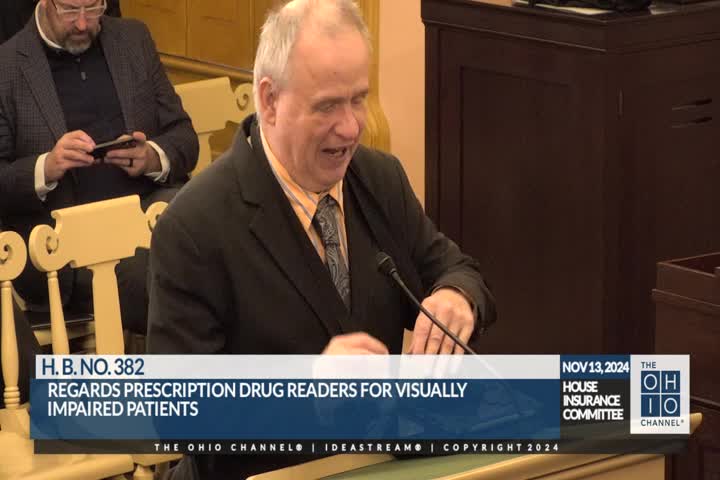Advocates push for accessible medication labels for the blind
November 13, 2024 | Insurance, House of Representatives, Committees, Legislative, Ohio
This article was created by AI summarizing key points discussed. AI makes mistakes, so for full details and context, please refer to the video of the full meeting. Please report any errors so we can fix them. Report an error »

During a recent government meeting, advocates for the visually impaired highlighted the urgent need for accessible medication labeling to improve safety and independence for individuals who are blind or have low vision. The discussion centered around the challenges faced by these individuals in identifying their medications, particularly when multiple prescriptions appear similar in appearance.
One speaker, Mr. Duffy, illustrated the issue by presenting three indistinguishable medication bottles, emphasizing that without proper labeling, individuals cannot discern which medication they are taking. He demonstrated a technology called ScriptTalk, which utilizes RFID tags on medication bottles to provide audible information about the medication through a smartphone or a dedicated reader. This system allows users to access critical details such as dosage instructions, expiration dates, and refill information.
Duffy pointed out that while some pharmacies, particularly smaller neighborhood ones, have successfully implemented accessible labeling, larger chains like Giant Eagle, Kroger, CVS, and Walgreens have not. He criticized these larger pharmacies for their lack of initiative, despite the relatively low cost of implementing such systems, which he compared to the annual membership fee for Amazon.
The Ohio Board of Pharmacies has expressed support for legislation aimed at mandating accessible medication labeling, stating that it should be the legislature's responsibility to enact such measures. Duffy urged committee members to prioritize this legislation, emphasizing that blindness can affect anyone at any time and that accessible medication information is a matter of health and safety.
Committee members engaged with Duffy, seeking clarification on the technology's functionality and the historical context of medication labeling for the visually impaired. Duffy explained that prior to modern technology, individuals often relied on rudimentary methods such as braille labels, rubber bands, or tactile identification, which were insufficient for ensuring accurate medication management.
The meeting underscored a critical gap in healthcare accessibility for the visually impaired and the pressing need for legislative action to ensure that all individuals have the necessary tools to manage their health safely and effectively.
One speaker, Mr. Duffy, illustrated the issue by presenting three indistinguishable medication bottles, emphasizing that without proper labeling, individuals cannot discern which medication they are taking. He demonstrated a technology called ScriptTalk, which utilizes RFID tags on medication bottles to provide audible information about the medication through a smartphone or a dedicated reader. This system allows users to access critical details such as dosage instructions, expiration dates, and refill information.
Duffy pointed out that while some pharmacies, particularly smaller neighborhood ones, have successfully implemented accessible labeling, larger chains like Giant Eagle, Kroger, CVS, and Walgreens have not. He criticized these larger pharmacies for their lack of initiative, despite the relatively low cost of implementing such systems, which he compared to the annual membership fee for Amazon.
The Ohio Board of Pharmacies has expressed support for legislation aimed at mandating accessible medication labeling, stating that it should be the legislature's responsibility to enact such measures. Duffy urged committee members to prioritize this legislation, emphasizing that blindness can affect anyone at any time and that accessible medication information is a matter of health and safety.
Committee members engaged with Duffy, seeking clarification on the technology's functionality and the historical context of medication labeling for the visually impaired. Duffy explained that prior to modern technology, individuals often relied on rudimentary methods such as braille labels, rubber bands, or tactile identification, which were insufficient for ensuring accurate medication management.
The meeting underscored a critical gap in healthcare accessibility for the visually impaired and the pressing need for legislative action to ensure that all individuals have the necessary tools to manage their health safely and effectively.
View full meeting
This article is based on a recent meeting—watch the full video and explore the complete transcript for deeper insights into the discussion.
View full meeting
